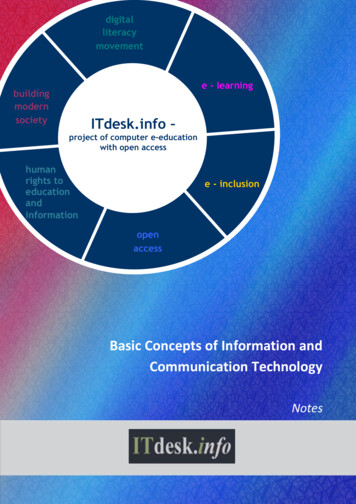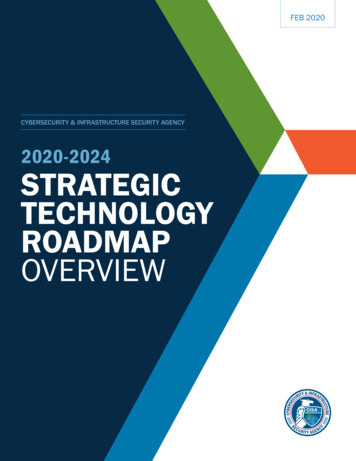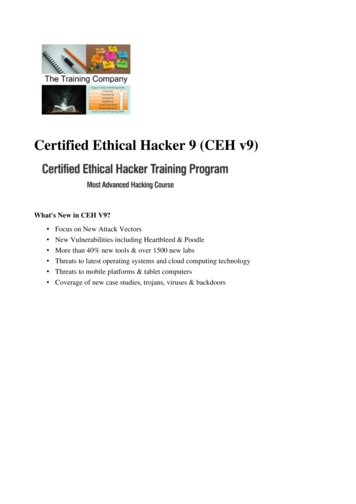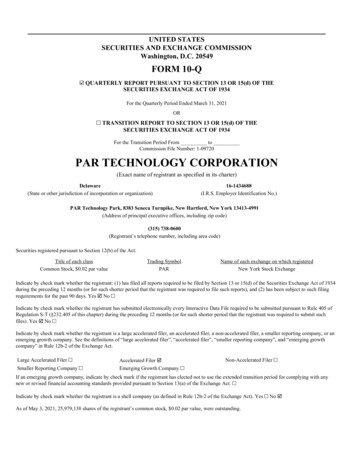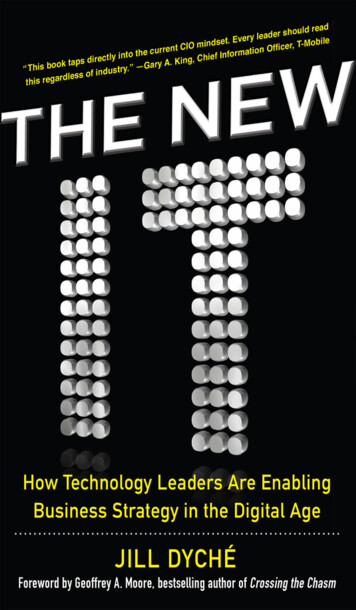
Transcription
0313233343536Praise for The New IT“The New IT taps directly into the current CIO mindset, regardless ofindustry. In a landscape of rapidly changing technologies and calls forgreater innovation, Jill concisely articulates the IT organization imperative to closely collaborate with business counterparts to succeed. Sheprovides clear templates, examples, and advice to start the importantconversations and lay the groundwork for wholesale success, not mereincremental change.”—Gary A. King, Chief Information Officer, T-Mobile“Jill has penned a Tocquevillian map of the digital world. The New ITshould be a required text for every business leader in the country.”—Thornton May, futurist and author of The New Know“Enterprise IT has reached an inflection point in how services are delivered and consumed, requiring our profession to undertake a transformation of our own. Jill Dyché describes well the challenges we face, howto assess them, and how to take action to complete the journey towardmodern enterprise IT.”—Kimberly Stevenson, Vice Presidentand Chief Information Officer, Intel“Jill Dyché’s new book is the first book on IT that I’ve enjoyed in sometime. Conversational, intuitive, and intelligent, Jill goes right to theheart of governance (control), innovation (change), identity (authority), relevance (alignment), and influence (strategy). It’s a timely bookthat should be read by executives across organizations.”—Peter Marx, Chief Innovationand Technology Officer, City of Los Angeles0071846980 dyche 00 r2 c.indd 112/12/14 7:05 PM
“Jill Dyché has written a highly readable, entertaining book that willhelp CIOs and their executive partners address the ongoing challengeof converting IT from a strategic liability to a strategic asset. The bookabounds with sound advice and profiles of extraordinary CIOs.”—Peter Weill and Jeanne Ross,MIT Center for Information Systems Research,and coauthors of IT Governance“Everywhere I go I hear complaints about the old IT. Jill Dyché’s bookprovides a comprehensive roadmap to changing IT to suit our analytical, consumer-driven, bring-your-own-device times. It’s both incrediblyuseful and fun. You need these ideas!”—Thomas H. Davenport, President’s DistinguishedProfessor of Information Technologyand Management, Babson College; author of Big Data @ Work;and coauthor of Competing on Analytics0071846980 dyche 00 r2 c.indd 212/12/14 7:05 PM
0313233343536WENT HEHow Technology Leaders Are EnablingBusiness Strategy in the Digital AgeJill DychéNEW YORKCHICAGOAT H E N S0071846980 dyche 00 r2 c.indd 3SAN FRANCISCOLONDONMADRIDMEXICO CITYMILANNEW DELHISINGAPORESYDNEYTORONTO12/12/14 7:05 PM
0313233343536ContentsForeword by Geoffrey A. MooreAcknowledgmentsIntroduction: Why This Book Is DifferentixxixiiiIT Challenges, Real and Perceived1What’s Wrong with IT?2The IT Leader’s Identity Crisis253Self-Assessment One: The Scope of the Problem533Your IT Transformation Toolkit4Strategy on a Page635Operations: Rethinking Your IT Portfolio876Organizational Models and IT Service Lines1197Innovation, Going Digital, and Other Uphill Battles1478Self-Assessment Two: Your Transformation Readiness183vii0071846980 dyche 00 r2 c.indd 712/12/14 7:05 PM
viiiContentsLeadership in the New IT9Fighting the Talent Wars19310Getting and Keeping a Seat at the Table21711Self-Assessment Three: Your Leadership Alignment241Coda251Notes252Song Lyrics CreditsIndex0071846980 dyche 00 r2 c.indd 825525712/12/14 7:05 PM
03132333435360071846980 dyche 01 r3 c.indd 112/12/14 7:11 PM
0313233343536What’s Wrong with IT?Sometimes I get discouragedSometimes I feel so downSometimes I get so worriedBut I don’t know what about.—Tom Petty & the Heartbreakers, “Century City” (1979)It’s a frigid wintry morning in Boston, and I hydroplane my way across thehotel parking lot, cursing myself for wearing four-inch heels as I grope inside my backpack for my rental car keys. Despite the ordeal, I’m finding thisan apt metaphor for the client I’m about to go visit, a CIO looking to navigate the slippery political terrain of his company, a multinational financialservices firm.When I arrive at Mike’s office, his assistant ushers me in, and I’m struckby the spaciousness of his new digs. I’d worked with Mike at his prior company, a regional bank, and he’d obviously moved up in the world. It’s beena year since I’ve seen him, and he gives me a big hug.“Great to see you, darlin’,” he says, and though never a bullshitter, heseems to really mean it.Besides the increase in square footage and the expansive view, Mike’snew office is different in another way. The walls are plastered with coloredimages of org charts, bar charts, and heat maps. I recognize a ForresterWave and a few Gartner Magic Quadrants as well as some operating frameworks my consulting firm had built for his prior company. Sitting behindhis massive desk surrounded by colorful matrices and charts, Mike seemsalmost childlike.30071846980 dyche 01 r3 c.indd 312/12/14 7:11 PM
4The New IT“Looks like you made a good move, Mike,” I say, taking a seat at hisconference table.Mike is standing at his Nespresso machine, steaming milk for my coffee. He hands me a demitasse cup, takes a seat at the table, and then bellows,“Sara! Shut the door!”The minute the latch closes, Mike looks at me, manages a tired smile,and puts his head in his hands. “This place is freakin’ nuts,” he says.He then regales me with a litany of problems, uncharacteristically rejecting the sunny synonym “opportunities” he had used when we workedtogether at the bank.“My predecessor was here for 14 years. Nice guy. They kicked him outjust shy of his 15-year anniversary, but I suspect by then he was secretlyhappy to go. He tried to make changes, but ultimately he had no power.Everything here is a silo. And the legacy systems are all built on a house ofcards. Half of my executive peers are pushing me to modernize. The otherhalf are off doing their own thing. There’s no way to keep everyone happy.As soon as I create an ally, I lose one.”I nod sympathetically. I’d heard different versions of this from otherCIOs, and at this point, I’m thinking of what Tolstoy said about how happyfamilies are all alike, but every unhappy family is unhappy in its own way.No two IT departments break in exactly the same place.Mike starts in on some of his executive colleagues, and the overall lackof vision. He mentions a book called Snakes in Suits,1 which links corporate behaviors to clinical attributes of psychopathology. I indulge him inhis rant. He cracks a joke that if someone doesn’t change the financial services industry soon, he’ll be putting his retirement fund into an offshore account. He then launches into a tirade about IT industry analysts before Ifinally interrupt him.“Mike,” I say, “let me just ask you something.”“What?” he says, blinking.“I get what’s wrong. You and I have both seen it before. But what doyou need?”“Jill, isn’t it obvious? I need an operating model!”“Let me ask the question a different way. Who do you want to be?”Mike puts down his espresso and looks at me as if I’ve just fallen off acharm bracelet.0071846980 dyche 01 r3 c.indd 412/12/14 7:11 PM
What’s Wrong with 82930313233343536The Problem with ITIt’s a discussion in meeting rooms, boardrooms, hotel conference rooms,and post-conference cocktail parties: Why isn’t IT working? Ask anyone ina corporate or government job and you’ll get an earful. As I was writing thisbook, I’d occasionally throw the question out to friends, clients, and beleaguered airplane seatmates.The responses come fast and furious. They don’t speak our language.They’re too focused on résumé building and tinkering, not on driving business value. We don’t understand what they’re saying when they talk tous. They play favorites with vendors. The CIO hides in his office. They’realways “in the weeds.”A few years ago during a session with the marketing staff at a large consumer products company, I asked the group of marketing professionals todictate a “take no prisoners letter” to IT. The letter would allow for an honestlist of grievances. It could only be a single page long, so that the importantpoints came through, and it should include suggestions as well as complaints.We wouldn’t send the letter—this would encourage complete honesty—but we would use it as the lightning rod for the group’s frustrations.As the team talked, a litany of complaints emerged that subsequentlytook form in the following letter:Dear IT Team:Long time no see. And by that, we mean, Where the hell haveyou been? We know you’re around. Seems you’ve been complaining to our execs about the lack of business engagement.That we never talk to you. And now you’re mad that we’ve hiredconsultants to come in to help us build a roadmap.Well, guess what? We had no choice. While you’re lettingthat big ERP vendor buy you lunch and having dashboardbake-offs and devising new coding standards—again—we havework to do. It may have slipped your mind, but . . . Newsflash!The company has just downsized. Despite this rough patch, ourresponsibilities haven’t changed. Remember the CEO’s companywide webcast in January? The one where he promised that in0071846980 dyche 01 r3 c.indd 512/12/14 7:11 PM
6The New ITthe coming year the company would cut costs while increasingcustomer acquisition and driving innovation? Well, that’s ourjob. And we’re trying to get it done.At this stage we’re not sure whether to feel resentment orresignation. After all, we know what you guys have been spending, and, frankly, all that funding should support our needs,not yours. You’ve been loading data into a data warehouse foras long as we can remember. But no one’s asked us if we neededany of that data. And if we hear the question, “What keeps youup at night?” one more time from one of your business analysts,we’re going to throw the poor bugger down the elevator shaft.Odds are he’ll bounce off one of those big servers in your datacenter.We read someplace that IT is supposed to act as a supplierto the business. We deal with suppliers all the time. But noneof them expect us to understand their internal processes—theyjust help us solve our problems. You guys keep insisting that wework within your framework. Whatever it is.Here’s what we’d like. We’d like to track the results of ourmarketing campaigns by the hour and make continuous adjustments. We’d like to monitor and respond to the buzz about thecompany through social media listening. We’d like the accountreps to know about support and payment issues when they’rewriting customer bids. We’d like to understand what’s involvedin pushing product recommendations to customers in real time.We’d like our finance and sales numbers to reconcile.So while you’re mounting your crusade against our consultants and lamenting our shoddy technical skills, why don’t youschedule a face-to-face meeting with us and ask us about this list?No, this isn’t another requirements gathering session. Instead,it’s us offering you an opportunity to participate. We’re hopeful that maybe you can help us solve some of these problems?Or maybe it’ll just be business as usual.In characteristic anticipation of something new,Your Marketing Users0071846980 dyche 01 r3 c.indd 612/12/14 7:11 PM
What’s Wrong with IT?7This exercise was fun for this team, letting them blow off a little steamand renew their esprit de corps. I asked the team members if they felt likesharing the letter with anyone, or whether they’d like to keep it as an artifact of what we all hoped could be an evolving collaboration. Someone evensuggested printing the letter and burning it, letting the smoke waft throughthe air vents and into the CIO’s office.Then the CMO suggested that perhaps IT deserved equal time. I offered my services as an honest broker to the IT organization. With theCMO’s permission, I convened a handful of IT managers and directors,reading marketing’s letter aloud and then leading the IT team through asimilar letter writing exercise. Here’s what they came up 282930313233343536Dear Marketing Team:Thanks for your letter and for taking the time to write it. We’resurprised you knew where to send it since we never see youover here.In fact, we’re working hard, and we’re grateful for any typeof feedback. Speaking of which, we invited you all to a lunchand-learn session last Thursday where we presented a prototypeof the customer event management (CEM) solution you’ve allbeen asking for. We’re one step closer to predicting the churn ofhigh-value customers, but we need your input. Most of you accepted the meeting invitation, but only four of you showed up.What happened?Okay, we don’t want to seem defensive, but if you don’t feellistened to, well, neither do we. We understand that you’re notwild about those architecture and infrastructure conversations,and we try to shield you from that stuff whenever we can. Butsometimes we need your approval for investments in foundational technologies. If IT indeed supports the business, bothsides need to know what’s being supported.But since you asked, we’ll tell you where we’ve been. We’vebeen trying to explain to you that we can’t develop the customsoftware you’ve requested for a packaged price. It seems you allwant “Google-simple” software on your desktops. Not to burstyour bubble or anything, but here it is: there’s really no such0071846980 dyche 01 r3 c.indd 712/12/14 7:11 PM
8The New ITthing as technology in a box. Stuff needs to be integrated. So,to answer your question for the ninety-ninth time: no, you can’tjust “plug and play.”We’ve also been delivering the 24 7 support you’vewanted—or haven’t you looked at the service-level agreements(SLAs) we created? This stings a little since we’re on call day andnight. You don’t know this because you’re fast asleep while we’reupgrading the operational systems that feed your campaignmanagement tool. Sure, you want pretty dashboards on yourdesktops, but the company is running huge mainframe systems.We can’t even get you guys to come look at the stuff we’re building for you. At lunchtime. With sandwiches.Our conundrum is this: the business funds IT, so we’re beholden to you for money. Yet when we want to make sure yourmoney is used well, we can’t get you to share where you’re going,let alone evaluate the solutions you’ve asked us to build.Look, we’re happy to rethink the way we work together,to collaborate better. We’re even happy to fund a resource toshadow you while you do your jobs so we don’t have to keepon asking you what’s next. But we need you to meet us halfway.Shoot, we need you to meet us, period. How about lunch?You know where to find us. We’re (literally) always here,Your Corporate IT ColleaguesIt’s an ongoing battle, and more often than not, IT gets the blame. Indeed, IT bashing has become de rigueur not only in boardrooms but in thepopular press and online. Business magazines are rife with discussions ofhow CIOs can get a seat at the table, how often the CIOs report to CFOsand COOs (versus CEOs), and reasons why the collective reputation of ITleaders has nosedived.Forbes asked, “Why Doesn’t the Role of the CIO Ever Solidify?” echoing a TechRadar article that asked, “Is the Role of CIO Still Essential toBusiness?” Bill Inmon, known in analytics circles as the “father of datawarehousing,” ranted in a blog post:0071846980 dyche 01 r3 c.indd 812/12/14 7:11 PM
What’s Wrong with IT?9So is it any wonder that the corporation does not trust itsIT leadership when it comes to bringing in new technology?Hasn’t IT leadership made every wrong decision in the book?If history is any indicator, why should any corporation trust itsIT 27282930313233343536Each of us has seen IT dysfunction in action, and it’s never pretty.Scope creep invites projects that are late and over budget. Technically inclined staff are more comfortable playing in the technology sandbox thansolving business problems. IT has a dearth of good communicators. Lack ofleadership and direction by both corporate and IT management results in“bright shiny object syndrome.”For every problem, IT has its own halfhearted excuse. And when itcomes to fixing those problems, the same tired shibboleths are trotted outas promising resolutions.Kickoffs and Cold CutsMy client Mike’s desire for a framework—an operating model he coulduse as a template for redesigning his own broken department—was, in reality, a cry for help in the standard language of the CIO. Mike was simply, perhaps admirably, looking for a proven structure that he couldleverage on behalf of his new firm. He had used frameworks in the pastto communicate direction, and they had always worked. My team haddesigned an IT operating model for him at his old company, one that reflected its landscape of platforms and applications. He wanted a new one, afresh one on which he could model his organization—and thus define hisown role.Indeed, IT leaders are comfortable with operating frameworks thatmingle resource allocations, budgets, and projects. Absent such frameworks, IT executives are left to their own devices. They often blame othersfor their growing problems. I’ve heard variations of the situations listed inTable 1.1 firsthand from executives tired of repeated attempts at fixing ITproblems, and they all fit within a few common themes.0071846980 dyche 01 r3 c.indd 912/12/14 7:11 PM
10The New ITTA B L E 1 . 1 :Common Excuses for IT Status QuoTheme and/or ExcuseTelltale SignsActual Quote from anIT ExecutiveLack of leadership The CEO doesn’t establish clearmeasures for IT executives. Key decision makers ignore IT orfail to engage. IT executives are not involved inbusiness planning. Charismatic or visibility-focusedCEOs may not view technologyas newsworthy.“He keeps saying ‘just keep doingwhat you’re doing.’ But I’m gettingbad performance reviews, andI’ve been disinvited to the boardmeetings. I didn’t do anythingwrong. The question is, Am I doinganything right?”Lack of strategy The CEO or board of directorsdoesn’t clearly communicatecorporate direction. Key initiative owners don’tinvolve IT in planning orbudgeting. There’s a general failure to linktechnology to corporate goals.“The only way I can figure outwhere the company is going is byreading our annual report.”The need formodernization Aging systems require inordinatetime and resources to maintain. Confusion about emergingtechnologies results in inertia. Legacy systems have becomepart of the cultural norm.“They keep talking about using ITfor first-mover advantage. But I’mup to my eyeballs trying to replaceour 30-year-old mainframe and our20-year-old customer informationfile. There’s no time for anythingnew.”Lack of budget orheadcount IT budgets get incrementallysmaller as lines of businesslaunch their own projects. New job openings linger due tolow salaries or poor companyreputation. Repeated funding requestsare rejected in favor of non-ITspending.“The CEO and board keep tellingme that IT is a differentiator. ButI’ve had open job reqs for threedirector-level positions I can’tfill because the pay’s so low. Ihave to personally attend designmeetings!”0071846980 dyche 01 r3 c.indd 1012/12/14 7:11 PM
What’s Wrong with IT?Theme and/or ExcuseTelltale 27282930313233343536Actual Quote from anIT ExecutivePressure topreserve the base Classic revenue sources areprotected at the expense of newproduct ideas. Fear exists that innovation willlead to cannibalization. There is unwillingness to sunsetoutdated or obsolete products. The increasing threat ofdisruptive competitors is beingignored.“Sales for our bestselling productsare down. We need to redirectresources to increasing thoserevenues. It’s never the righttime to explore new productsor services—or to formalizeinnovation.”Style differences IT leaders cite personalitydifferences with corporateleadership as a barrier toengagement. IT’s culture doesn’t reflect that ofthe corporation at large. Visionary CIOs have difficultyrefocusing their staffs towardinnovation.“We can’t stand her. She likes tohear herself talk in meetings, andshe doesn’t listen. She doesn’taccept suggestions, and sheis unavailable for one-on-onediscussions. So I just keep quiet.My next company will get my goodideas.”Poorunderstanding ofIT’s value IT leadership reports to the CFOor COO, not to the CEO. Backward-looking corporateboards perceive IT as a sharedservice. There is pressure to outsourcepotentially differentiatingtechnologies. IT is marginalized as anoperating expense. A strict hire-from-within policymeans a dearth of new thinkingor fresh perspectives.“I’ve been trying to sell the CFO oninvesting in analytics. Then he tellsme to bring system upgrade costestimates to the next executivestaff meeting. I guess that’s allI need to know about how we’remeasured!”Reactions to these all-too-real phenomena tend to focus more on personalities than on processes or systems. In fact, the sentence “Maybe weneed to bring someone in from the outside” has left the lips of CEOs andCIOs alike in an effort to rectify these and other problems. The outsider canbe a technology consultant, a systems integrator, a strategy guru, or an executive coach. The point is that he, she, or they won’t be on the inside, andthus they will bring an unbiased perspective to the issues. They will have theexperience to recommend a plan of action, and they’ll have the authority tobe taken seriously.0071846980 dyche 01 r3 c.indd 1112/12/14 7:11 PM
12The New ITThe external firm comes in, holds a kickoff meeting (lunch will be fromPanera or some other purveyor of sandwiches-and-slaw), in which everyone isasked for opinions. The extroverts participate, citing the need for more IT budget or the business side’s poor attention span, while the introverts process andtake notes. I call this the Kickoff and Cold Cuts Approach to IT planning.The consultants listen and develop some initial ideas (often reflectingthe viewpoint of the person who hired them), which they discuss at the barafter the session.Then they draft up a PowerPoint presentation, delivering a “readout” totheir sponsor. They tweak their bullet points based on their sponsor’s feedback—which sometimes contradicts their original recommendations—anddistribute the document to the meeting participants. This process is represented in the cycle diagram in Figure 1.1.Figure 1.1 The Ersatz IT Improvement CycleThe result usually falls short of the original goals. Rather than drivingwidespread process changes that might introduce significant efficiencies or0071846980 dyche 01 r3 c.indd 1212/12/14 7:11 PM
What’s Wrong with IT?13encourage innovation, the exercise results in small refinements or incremental tweaks that ultimately don’t cover the cost of the consultants. Byfailing to address the root cause, or worse, by not identifying who they wantto be and what their organizations want to be, the executives are simplyputting their fingers in a hole to stop the spillage, until another hole develops. Over time, the entire effort fizzles.Many IT managers and executives have come up through the technicalranks, and they are therefore comfortable making incremental refinementsto processes, just as they did to their code earlier in their careers. And mostof them understand that an inability to drive wholesale change isn’t theirfault; it’s the fault of the executives and boards they report to. A lack of vision for the future—indeed, the inability to see IT’s potential to enrich theorganization—is the fault of the company’s top 627282930313233343536The New GatekeepersIT is at a moment when its future is being redefined, and its cultural poweris shifting to a new set of gatekeepers. I joke in my conference keynotes that“there’s nothing more dangerous than a CEO who’s just read an airline magazine.” After all, we’ve all sat across a conference room table from an impatient executive who’s asked about a current trend without understandingthe complexity of its implementation. (Cloud, anyone?)Who are these new gatekeepers? They fall into two classes, business unitsand customers, and their dominance in the IT conversation is growing.The Business Unit RisesResearch has found that almost half of the CEOs described CIOs as beingout of touch with the business and unable to understand how to apply ITin new ways. Over half also considered IT “a commodity service purchasedas needed.”3Clearly most CEOs haven’t positioned IT as a strategic differentiator,never mind inviting their CIOs to weigh in on the conversation. The result?Lines of business, particularly marketing and finance organizations, are obtaining their own IT budgets and setting their own technology courses.0071846980 dyche 01 r3 c.indd 1312/12/14 7:11 PM
14The New ITThere are certainly cultural and even economic reasons for this shift.But the overarching reason is that business executives are more comfortable with technology than ever before. Marketing vice presidents routinelyprocure and implement multi-million-dollar customer relationship management (CRM) solutions. Chief financial officers have their favorite applications for balancing their general ledgers. Product managers downloadinventory reconciliations onto their iPads. A doctor can view her patient’svital signs from her smartphone. Even our home appliances are talking backto us!And vendors have capitalized on these tech-savvy business users. Visitany large company and you’re likely to find a multitude of so-called packaged applications and niche technology solutions obtained without thehelp—and sometimes without the knowledge—of IT. Business units, measured on sales uplift, campaign response rates, or customer satisfaction, areneither accountable for nor concerned about the fact that they’ve implemented what are in effect new information silos. Integrated systems anddata simply aren’t their concern.At first, this incites questions. “Why did the business go behind ourbacks?” IT asks. “Why didn’t they engage us?” Resentment sets in. “Theydon’t know the first thing about managing a relationship with a cloud provider!” This ultimately leads to inevitable political tensions, each side defending its turf while furtive efforts to showcase expertise results in circlingthe wagons.These behaviors become entrenched, and eventually they become partof the corporate culture. At this point they’re almost impossible to undo,so CEOs and COOs throw up their hands, in effect sanctioning businessunit independence and encouraging other departments to build their ownrogue systems. There are no penalties. Thus so-called shadow IT comes outof the closet.Customer Focus Comes Home to RoostAs with internal business executives, external customers are also gettingsmarter about technology. A company’s ability to leverage IT to improve itsrelationship with customers can affect nothing less than competitive advantage. The so-called consumerization of technology has meant that a shopper0071846980 dyche 01 r3 c.indd 1412/12/14 7:11 PM
What’s Wrong with IT?15can now go online with a few taps of her smartphone to find the best priceon the product she wants, and with a few more taps, buy it. Welcome to thedigital enterprise.Likewise, social media sites are connecting companies with consumersirrespective of brand presence or marketing budget. “I know how to compete with my known competitors,” one retail CEO told me recently. “It’sthe small guys eroding my margins that I can’t keep up with.” Indeed, unencumbered by years of history, aging management teams, or establishedbusiness processes, smaller companies with strong social media presence arenipping at the heels of established brands. We need look no further thanBlockbuster, MySpace, and Kodak to view the carnage.Indeed, consumers are moving toward technology and away from largeadvertising budgets and branding to decide where to buy products and attainservices. The website Craigslist has replaced the Yellow Pages, and word-ofmouth is more viral (and to some more credible) when it happens online.While this has been a boon to small startups and the venture capitalists who fund them, it can be unsettling to executives at established companies saddled with decades-old legacy systems and deep-rooted cultures.As Nicco Mele explains in his book The End of Big, the advantages of scaleenjoyed by most big companies are 252627282930313233343536In the past, to have big and powerful clients as a lawyer, youneeded to be at a big firm, because only a big firm had access toa wide range of resources: large research teams, expensive subscriptions to legal journals, and secretaries to help you managelarge volumes of paper that provided you with a research advantage. Today, with the help of simple online services like GoogleSearch and specialized cloud-based software for the legal profession, a big firm’s allure has substantially diminished.4As a result, says Mele, more and more small companies are cropping upand staying small. These companies are attracting the attention of your customers, and they could become your competitors.For CIOs of more traditional companies, this means new pressures tomodernize, exploiting their firms’ scale and financial resources while at thesame time thinking of new ways to become more nimble and innovative.0071846980 dyche 01 r3 c.indd 1512/12/14 7:11 PM
16The New ITThe problem is that CEOs aren’t measuring these CIOs for modernizationor innovation. Instead, they’re rewarded for keeping the lights on.Forging
“Jill Dyché’s new book is the first book on IT that I’ve enjoyed in some time. Conversational, intuitive, and intelligent, Jill goes right to the heart of governance (control), innovation (change), identity (author-ity), relevance (alignment), and





